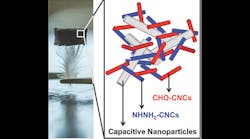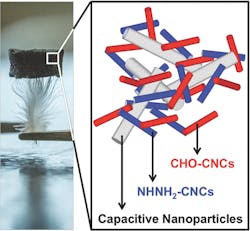As technology relentlessly forges ahead, design engineers also continue to search for sustainable solutions to benefit future generations and minimize negative effects on the environment. To that end, engineers at McMaster University are currently researching cellulose’s capabilities as a substrate for conductive nanoparticles as they look to reform supercapacitors and regenerative-energy technology. According to the abstract of the report in Advanced Materials, the cellulose-based supercapacitors demonstrate “excellent capacitance retention, low internal resistance, and fast charge-discharge rates”.
Cellulose, a renewable and sustainable material found in the cell walls of plants, algae, and bacteria, has been widely analyzed as a substrate in nanotechnology. But methods to seed cellulose with functional nanoparticles are often complex, requiring the use of heavy binders and complicated preparatory cellulose-coating processes. Furthermore, additives are often required to make the cellulose aerogel self-standing; these, in addition to functional particles, increase the weight of the aerogel.
The McMaster team presents a one-step method to seed cellulose gels with conductive nanoparticles during construction of the gels. The resulting lightweight conductive aerogel can be formed into a range of different 3D, self-standing shapes with high resilience and flexibility.
The conductive aerogel consists of cellulose nanocrystals and nano-conductors that are crosslinked in a random, net-like arrangement to create a porous aerogel. This new in-situ approach preserves the porous microstructure, shape-recovery abilities, and mechanical properties of a pure cellulose-nanocrystal aerogel.

